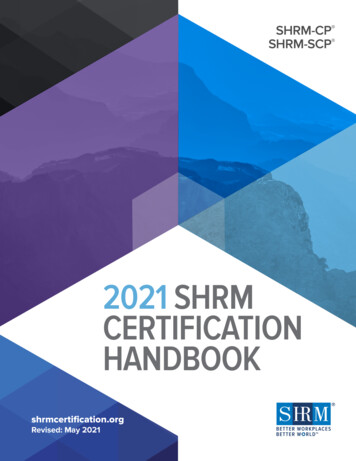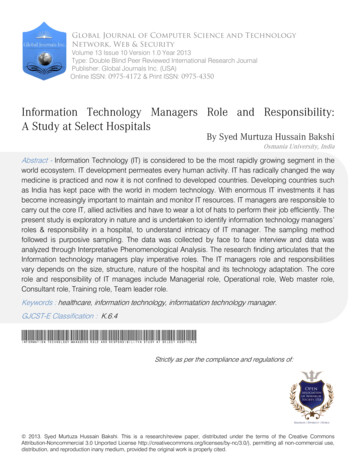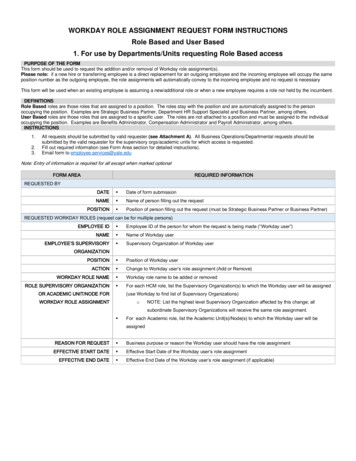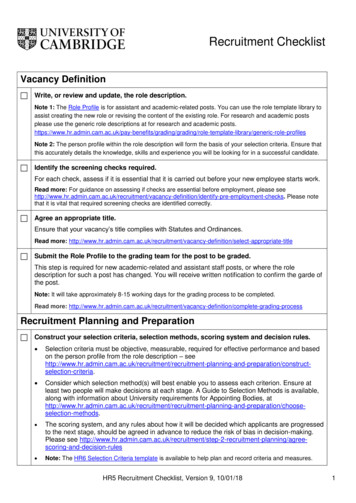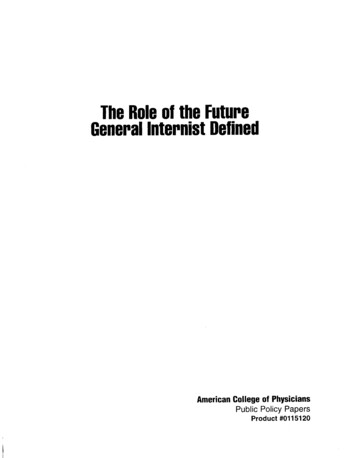
Transcription
The Role of the FutureGeneral Internist DefinedAmerican College of PhysiciansPublic Policy PapersProduct #Oil 5120
Copyright1994 American College of PhysiciansAll rights reserved. Individuals may photocopy all or partsof Public Policy Papers for educational, not-for-profit uses.These papers may not be reproduced for commercial, forprofit use in any form, by any means (electronic,mechanical, xerographic, or other) or held in anyinformation storage or retrieval system without the writtenpermission of the publisher.For questions about the content of Public Policy Papers,please contact the American College of PhysiciansDepartment of Public Policy, Suite 250,700 ThirteenthStreet NW, Washington DC 20005.202-393-1650To order copies of position papers, contact ACPCustomer Service at 800-523-1546, extension 2600,or 215-351-2600.How to cite this paperAmerican College of Physicians. The role of thefuture general internist defined. AM Intern Med. 1994; 121:616-22.
PAPERPOSITIONReprinted from ANNALS OF INTERNAL MEDICINE Vol. 121; No. 8, 15 OctoberPrinted in U.S.A.1994The Role of the Future General Internist DefinedAmerican College of Physicians*n In this positionpaper, the American College of Physicians Task Force on Physician Supply examines the current and future roles of the ideal general internist. Discussed are the characteristics shared by all internists,whether engaged in general or subspecialty practice; current trends and the growing crisis in the supply of primarycare physicians; and the practices and patient characteristics of both general internists and family physicians.The Task Force considered four options for the futuregeneral internist but rejected them because they eithermaintained the status quo or were retrogressive: 1) allowing the community-based general internist to disappear;2) strengthening the generalist’s identity as a primarycare-orientedphysician who provides no subspecialtycare; 3) becoming hospital-based generalists who act principally as consultants; or 4) becoming fully trained subspecialists who also provide primary care.The Task Force proposes a new definition that reaffirms fundamental characteristics of today’s general internists and adds characteristics that should be the hallmarkof the general internist of the future. The paper describescharacteristics that are shared by other generalist physicians and those that are distinctive to today’s generalinternist. It then addresses characteristics that will beneeded to prepare for the environment of medical care inthe future. The new definition reaffirms that the generalinternist is an expert in the general care of the adult, butit also revives the concept of the general internist as alocal authority on a specific topic in which he or she hasspecial expertise.The paper concludes with a discussion of some of thequestions that its definition poses for graduate medicaleducation. The Task Force suggests that changes in theeducational system to produce the desired mix of skillsrequired for the general internist of the future will increase the attractiveness of general internal medicine.Ann InternMed. 1994;121:616-622.* This paper was authored by Harold C. Sox, Jr., MD; H. Denman Scott,MD, MPH; and Jack A. Ginsburg, MPE. It was developed for the ACPTask Force on Phvsician Supply: James P. Nolan, MD, Chair; WilliamCannon, MD; Clifton R. Cleaveland, MD; Robert Copeland, MD; FrankDavidoff, MD; Susan Deutsch, MD; F. Daniel D&y, MD; Paul A. Ebert,MD; Robert I. Frye, MD; Paul F. Griner, MD; Rolf M. Gunnar, MD;Ruth Hanft, PhD; Howard Shapiro, PhD; Anthony So, MD, MPA; JosephS. Solovy, MD; and Steven A. Wartman, MD, PhD. Approved by theBoard of Regents on 18 April 1994.6160 1994American College of PhysiciansInternal medicine is changing. Patient populations arechanging. Patient care needs are increasingly shifting fromshort-term care to care for long-term illnesses and frominpatient hospital settings to outpatient ambulatory caresettings. Dramatic and rapid advances and innovationshave been made in the diagnosis and treatment of illnessand in the organization and delivery of health care services. There is a growing appreciation of the need forprimary care physicians, particularly for physicians such asgeneral internists who can analyze and solve difficult,complex patient care problems that often involve multipleorgan systems. Yet patients, medical school students,third-party payers, public policy makers, and even internists themselves have trouble defining the general internist and his or her appropriate role.Health maintenanceorganizationsand large grouppractices often define the general internist’s role somewhat differently than do physicians in solo or fee-forservice practice. Geographic factors influence what thegeneral internist does. Rural internists typically do moreintensive care and procedures than do their colleagues inpopulous areas. Current ambiguity about the role of thegeneral internist and the rapidly changing health careenvironment require that the role of the future generalinternist be more clearly defined, especially because themission itself is changing.The American College of Physicians convened its TaskForce on Physician Supply to address the issue of definingthe future general internist and several other related andpressing questions. Does the existence of family practitioners and internal medicine subspecialists leave any uniquerole for the general internist ? How should graduate education in internal medicine change to address the growingdeficit of general internists and the surplus of subspecialists in internal medicine. 3 What are the roles of nursepractitioners and physician assistants in solving the nation’s primary care crisis.3 We address the Task Force’sfirst charge, to define the future general internist.Members of the Task Force included general internists,internal medicine subspecialists and a surgeon, full-timepractitioners and full-time medical school faculty clinician-educators, and a health economist-patient.The TaskForce met four times. Before the second meeting, themembers did several exercises designed to form a consensus about the relation of the general internist’s work tothe work of medical subspecialists, family practitioners,and nurse-practitionersand physician assistants. The TaskForce defined the relation in functional terms, such asofclinical preventive services, triage, and managementacute self-limited illness and advanced or unstable chronicdisease. Each Task Force member then judged the extentto which each type of practitioner performed each function, both in the clinical practice of the present and in thefuture. These exercises brought the Task Force to a starting point for defining the role of the general internist.
A physician who completes an internal medicine residency program lasting a minimum of 3 years is an internist. In this report, the Task Force uses the followingterms to differentiate types of internists. For the primarycare internist who provides comprehensive care to adultpatients, the Task Force uses the term general internist.Others prefer the term “comprehensive internist” or even“internist.” For the internist whose practice is limitedentirely or in part to the care of patients with selecteddiseases (for example, cardiologists and endocrinologists),the Task Force uses the term subspecialty internist.States. The probable-andappropriate-responseis toset a high priority on increasing the number of physicianswho can fulfill primary care functions, with a complementary reduction in the supply of newly trained subspecialists. As society redresses its oversupply of subspecialists,there is a risk that it will devalue subspecialists and theirrole in the U.S. health care system. The Task Forcebelieves that society should alter the balance of the supplyof generalists and subspecialists while placing a high valueon all types of physicians who contribute to our highstandard of health care.General InternistsGeneral Internistsand SubspecialtyInternistsThe general internist and the subspecialty internist havemuch in common.1. They are inseparable, complementarypartners inproviding health care to adults. General internists pridethemselves on meeting most of their patients’ needs forinternal medicine care. However, most general internistshave valued colleagues in each subspecialty of internalmedicine. They rely on these physicians to give informaladvice, to provide formal consultation, and, occasionally,to assume the care of the patient. The partnership between generalists and subspecialists assures each patientaccess to the full range of care.2. The general internist and the subspecialty internistshare common training in a discipline characterized by atime-intensive, painstaking, detailed approach to complexproblems. This common stem creates a pluripotent physician who should be able to adapt to changing demandsfor different types of health care.3. The distinction between the general internist and thesubspecialty internist often is drawn too sharply. In fact,there is a continuum of practice styles along a spectrumbounded at one end by the pure general internist and atthe other by the purely consultative or procedure-basedsubspecialist. Internists in some subspecialty disciplinesoften assume complete responsibility for comprehensivecare of patients who need their specialized services (forexample, patients receiving chemotherapy or renal dialysisand patients with human immunodeficiency virus infection). Many subspecialty internists have a mixed practicein which they provide primary care for many of theirpatients. On the other hand, many general internists, especially those in rural locales, have a special area ofexpertise within internal medicine and may do proceduresthat in urban areas are the exclusive province of thesubspecialty internist.Current Trends and the Crisis in the Supply of PrimaryCare PhysiciansThe aging of the population, expectations of universalhealth insurance coverage, expanded use of managed careand other changes in health care needs, the practice ofmedicine, and the delivery of health care services haveincreased the demand for primary care. The most efficientand effective way to use the physician work force is to relyon generalist physicians to provide the bulk of primarycare to adults. However, the number of physicians electing to pursue a career in primary care has decreased,resulting in a physician work force crisis in the United15October 1994and Family PhysiciansIn a nation that values pluralism, it is fitting that medical students of different temperaments can choose amongseveral approaches to the care of adults. Some prefer apractice that emphasizes the care of adults and seek indepth training in internal medicine. Others prefer a practice comprising patients of all ages and seek training inmany disciplines, such as that encompassed by familypractice. The type of patient seen by general internistsand family practitioners and the content of internal medicine and family practice training are good starting pointsfor comparing these two disciplines.The Medical Outcomes Study allows a comparison ofthe practices of general internists and family practitioners.The study was a prospective, cross-sectional analysis ofslightly more than 20 000 patients seen by 349 physiciansin 1986 in carefully chosen practice sites (1, 2). The studycompared medical outcomes and resource use in patientsof family practitioners, general internists, and two internalmedicine subspecialties. The investigators adjusted for differences in the characteristics of patients seen by internists and family practitioners. The patients of generalinternists and family practitionersand the physicians’rates of resource use (adjusted for patient mix) are compared in Table 1. Patients of family practitioners are anaverage of 7 years younger than those of general internists. Only 10% of family practitioners’ patients wereolder than 65 years compared with 20% of general internists’ patients. The patients of general internists viewedthemselves as sicker and less functional than patients offamily practitioners. The internists’ patients also had morechronic diseases. General internists used the hospital anddiagnostic tests at about the same rate as family practitioners. The differences, although unmistakable, are lessstriking than one might expect from the stereotypical viewof the family practitioner as physician to the entire familyand the general internist as the physician of the chronically ill older person.The content of residency training provides another perspective on general internists and family practitioners.The content of residency training as recorded in the Essentials of Accredited Residencies (3) is summarized inTable 2. Family practice residents spend a minimum of 10months in rotations in pediatrics, obstetrics and gynecology, and surgery. They spend at least 8 months but nomore than 12 months in internal medicine rotations. Internal medicine residents spend at least 24 months ininternal medicine rotations in which they have direct careresponsibility under the supervision of internists, andmost use their elective time serving as consultants onAnnalsof InternalMedicinelVolume121lNumber8617
Table 1. Comparisonternal Medicine*of Family Practice and General In-VariableFamilyPracticePatient mixFamily size, nMean age of patients, yOlder than age 65 years, %Well-being (O-100 scale)Health perceptionsPhysical functioningRole functioningDisease prevalenceChronic illnesses perpatient, itAny chronic disease, %Adjusted resource use ratesPatients hospitalized peryear, %Prescription drugs perpatient, IIMean annual charge fordiagnostic tests, Office visits per year, nGeneral .641104.42* Informationon patient mix, well-being, and disease prevalence wasobtained from reference 1. Informationon utilization rates was obtainedfrom reference 2.internal medicine subspecialty rotations. A family practiceresident who wished to maximize time in internal medicine could spend as much as 18 months at the task,whereas an internal medicine resident could spend almost36 months in internal medicine. The content of internalmedicine training differs sharply from that of family pracJice training and offers a clear choice for medical studentswho wish to become generalist physicians.This brief review shows that internists see somewhatolder and somewhat sicker patients than do family practitioners and that internal medicine training provides indepth preparation for this task. In our pluralistic society,an important role exists for both internal medicine andfamily practice. Both disciplines should flourish in thecoming era of cost-containmentand growing entitlementto primary care. Their leaders should work closely toensure that the two disciplines are meeting the variedneeds of diverse practice environments and populations ofadult patients. Family practice and internal medicine residents should tailor their training to meet the needs of thecommunity they wish to serve and the form of practicethat they prefer-solo,small group, or large group. Training programs in both disciplines must be flexible enoughto enable residents to obtain the training that will bestprepare them for their desired type of practice (4).Options for the Future General InternistThe Task Force reviewed several options for the general internist.1. Allow the past trend to continue: a decreasing number of general internists and an increasing number ofpure internal medicine subspecialists blended with physicians who have a mixed practice. The community-basedgeneral internist might ultimately disappear, leaving thefield to subspecialty internists, the occasional hospital61815 October 1994lAnnuls of Internal Medicinelbased general internist, and family practitioners. The TaskForce believes that the disappearance of the communitybased general internist would be an irreplaceable loss foradults with complex, severe illness.2. Strengthen the general internists’ present identity asa primary care-oriented physician who provides no subspecialty care. The distinction between this option andfamily practice is clear enough to internists but perhaps isnot sufficiently crisp to help medical students, patients,and legislators make their decisions.3. Become a hospital-based generalist who acts principally as a consultant. The Task Force feels that this visionof the general internist would make it much more difficultfor adults to obtain convenient, continuing, comprehensive care when they become burdened with severe chronicillnesses.4. Be a fully trained subspecialist who also providesprimary care, as practiced today by many subspecialtyinternists. The Task Force feels that this strategy is notthe right approach to meeting the country’s needs forgeneral physicians. Rather, U.S. academic medical centersshould adjust their production of subspecialty internistsdownward until it is equal to the nation’s needs for subspecialty care.The Task Force believes that these options either maintained the status quo or were retrogressive. Furthermore,none responded fully to several facts: The United Statesneeds primary care physicians; many internists enjoy being sought for their expertise; and, in many locales, patients must travel great distances to obtain subspecialtycare.Definitions:FutureThe General Internist Today and in theBased on this background, the College Task Force onPhysician Supply recommends the following evolution inthe role of general internists. The Task Force envisionsthe general internist as a comprehensive provider for thehealth needs of adults and reaffirms several fundamentalcharacteristics of today’s general internist. Although several of these are features of other generalist disciplines,others distinguish the general internist from other physicians who provide comprehensive care to adults.1. A primary care physician: the patient’s first contactand a provider of comprehensive, continuing care.2. A physician who evaluates and manages all aspectsof illness-biomedicaland psychosocial-inthe whole patient.3. An expert in disease prevention, early detection ofdisease, and health promotion.4. The patient’s guide and advocate in a complex healthcare environment.5. An expert in managing patients with advanced illnessand diseases of several organ systems. Equally effective inthe office and in the hospital.6. A consultant when patients have difficult, undifferentiated problems or when the general internist has special expertise to apply to their problems.7. A resource manager who is familiar with the scienceof clinical epidemiology and decision making and canbring a thoughtful, lean practice style to evaluation andmanagement.Volume 121lNumber 8
Table 2. Comparison of InternalFamily Practice he Task Force strongly reaffirms the general internist’srole as a primary care physician for the whole person.The general internist cares for adults from adolescence tovery old age. In some countries, internists are hospitalbased and spend most of their time caring for patientswhose family practitioners have referred them for hospi-andFamily PracticeTotal time in ambulatorysetting, moTime in continuity ofcare setting, yTime doing continuity ofcare, yFirst year, d per week29r10.5.ttalization33practice of a few U.S. general internists,’ but the TaskForce rejects this model as a template for the future.3 preferred;2 requiredPreferred butnot required3 requiredweek1 half1 half2-4 half davs3-5 half dais1 halfOther surgicalsubspecialtiesObstetrics andgynecology, moEmergency medicinell,moDermatologyElectives, moRotations acting as aconsultant to otherservicesNot specifiedMinimalNot specifiedNot specified36 8-125Time not specified52-3200 hl-6NoneNoneAdvised, buttime notspecifiedAdvised, buttime notspecified31.5-3Advised, buttime notspecifiedNo more than12l-360-120 hSpecifiedNot specifiedThis element of the definitionemphasizessicians do cope effectively with the breadthmedicine practice.describethethe breadthof internal3. An expert in disease prevention, early detection of disease, and health promotion.Research in population-basedmedicine, especially dis-ease prevention and health promotion, is bringing newknowledge at a remarkable rate. As new understandinghas accumulated, physicians have realized that diseaseprevention is a complex activity that requires muchknowledge and judgment. Disease prevention in olderpersons is a special challenge to the general internist. It isalso a cornerstone of health system reform, which meansthat physicians will spend many more office hours onprevention.4. The patient’s guide and advocate in a complex health6* Information was obtained from reference 3.t Minimum time in ambulatory medicine was calculated by adding theminimum time specified in the family practice center, the minimum timein emergency medicine, and the minimum time in dermatology, orthopedics, ophthalmology, and urology. There must be 24 months of rotations in which the house officer hasmeaningful patient responsibility (responsible for decision making that issubject to review by the attending physician). Ambulatory rotations counttoward meeting this requirement, but elective rotations do not. Mostinternal medicine residents use most or all of their elective time to dointernal medicine elective rotations.0 If a family practice inpatient service exists, rotations on it counttoward fulfilling the internal medicine requirement.IIIn the emergency department, internal medicine residents see adultswith internal medicine or undifferentiated problems; family practice residents see patients from all age groups and with all types of problems.care environment.The complexity of today’s health care system is intimidating for many patients and families. Tomorrow promises to be no better for them. Other patients are victimsof fragmented care. A key role for the personal physicianis to organize their patients’ care and help them gainaccess to the care that they need. The complexity of themodern health system is a particular problem for very oldpersons, who have many health problems and may havephysical or intellectual disabilities that make them in special need of a vigorous advocate.8. A clinical information manager who can take fulladvantage of electronically stored data and can communicate using the tools of modern technology.9. A generalist in outlook who also possesses specialskills that respond to the needs of a particular care environment.Distinctive Features of Today’s General InternistGeneral internists have in common several traits thatare also typical of subspecialty internists. These traitsinclude eagerness to take on difficult problems and afascination with the scientific basis of medicine and medical practice.Similarities of Today’s General Internist to OtherGeneralist Physicians1. A primary care physician: the patient’s first contact anda provider of comprehensive, continuing care.15 October 1994mavof the general internist’sscope but perhapsdoes notsufficiently emphasize the depth of knowledge required tobe a general internist. As the knowledge base of medicinecontinuesto increase, the combinationof breadthanddepth might be too great a challenge were it not for thepromiseof the computer,with its ability to organizeknowledge and make it quickly available. Internal meditine training programs have done well in preparingresident physicians for the depth of reasoning required to bea general internist. Now, they are addressingthe task ofeducating resident physicians in the breadth of practiceskills needed to be a general internist. Internal medicinemust find a way to help medical students learn that phy-40-80 h inorthopedics,ophthalmology,and urologyNoneThisGeneral internists have the knowledge and depth of experienceto play a central role in the primary care ofadults.2. A physician who evaluates and manages all aspects ofillness- biomedical and psychosocial-in the whole patient.Second year, d perThird year, d per weekBlock ambulatoryrotationsTime on inpatientrotationsTime spent in specialtiesInternal medicine, moIntensive care, moPediatrics, moGeneral surgery, moOrthopedicsor office consultation.1. An expert in managing patients with advanced illnesslAnnals of Internal MedicinelVolume 121lNumber 8619
and diseases of several organ systems who is equally e ectivein the ofice and in the hospital.thoughtful, lean style of practice to evaluation and management.Caring for the most complex patients has always beenthe internist’s special role in the community. Patients withadvanced chronic disease require medical knowledge,judgment, and experience, as well as patience and skill inworking with community resources. Internists typically obtain great satisfaction from helping sick people extendtheir functional lives and from helping them find dignityand tranquillity during the last months of life. This role isbecoming increasingly important. People are living longer,and many face a long, gradual decline that poses manydiagnostic and therapeutic challenges. Whether in theintensive care unit, the office, or the home, the generalinternist is increasingly concerned with using expensiveresources wisely and in accordance with the patient’swishes. Managing sick patients efficiently in the hospitaland immediately before and after hospitalization is a focalpoint of the general internists’ training.2. A consultant when patients have dificult, undiflerenti-Personal physicians will have to reconcile two strongforces: the wishes of the patient and the limits on healthcare resources. Clinical epidemiology, decision analysis,and medical ethics contain principles that can help thephysician serve the patient’s interests when resource constraints are present. General internists in academic medical centers have taken the lead in applying these principles in their research and in teaching housestaff andmedical students how to use them. The application ofthese principles has led to many practical contributions tomedical practice. Whether in caring for the individualpatient or in working with colleagues to develop clinicalguidelines, the internist who can apply the lessons ofthese disciplines to daily practice will be a leader indefining standards of care in the community.2. A clinical information manager who can take fullated problems or when the general internist has specialexpertise to apply to their problems.Many older general internists remember when theywere sought-after consultants. For years, the term “diagnostician” was almost synonymous with “internist,” reflecting a key role in the professional community as asolver of difficult diagnostic problems. Judging from theundiminished number of unexpected major findings atautopsy (5) diagnosis is still a difficult art despite improved imaging techniques and the growth of subspecialtymedicine. Nevertheless, these developments have seriously eroded the general internist’s role as a consultant,especially in large group practices and metropolitan areas.Other physicians and patients seeking another opinionoften deal directly with subspecialty internists, despite thegeneral internist’s ability to deal with complex, undifferentiated problems.The role of consultant can be rewarding for the generalinternist. The general internist will often be the bestconsultant for a patient with an undifferentiated diagnostic problem. The flow of referrals between the generalinternist and subspecialty internist can be in two directions, with the subspecialist asking the generalist to takeover the management of a patient with multiple problems.The Task Force believes that the general internist consultant will play an important role in future health care,especially as the medical education system produces fewerspecialists in internal medicine and as increasing numbersof general internists have an area of special clinical expertise.The Future General InternistThe Task Force envisions that general internists of thefuture will differ in important ways from today’s generalinternist. The Task Force identified several characteristicsthat should be the hallmark of future general internists.The first two characteristics respond to changes in theenvironment of medical care. The third is as old as thediscipline of internal medicine.1. A resource manager who is familiar with the science ofclinical epidemiology and decision making and can bring a62015 October 1994lAnnals of Internal Medicineladvantage of electronically stored data and can communicate using the tools of modem technology.Modern information technology offers much hope forimproving medical practice. The desktop computer willspeed access to patient data, medical knowledge, andassistance in making difficult decisions. Analysis of electronically stored practice data will allow physicians tounderstand practice patterns and identify optimal practicestyle. Improved communication technology, such as electronic mail, two-way interactive video, and long-distanceaccess to electronically stored patient records, will meanwith colimproved patient care, better relationshipsleagues, and greater enjoyment of practice. Modern communications will greatly facilitate consultation by internists. Internists-in-trainingmust master the skills requiredto use these technologic advances.3. A generalist in outlook who also possesses special skillsthat respond to the needs of a particular care environment.Forty years ago, before the increase in advanced fellowship training and subspecialty board certification, general internists with an area of special interest providedinternal medicine subspecialty care. Even now, generalinternists, pediatricians, and family physicians have areasof special expertise in which they serve the community asthe local experts. In many rural settings, a small group ofinternists are the only physicians trained in internal medi
General Internists and Subspecialty Internists The general internist and the subspecialty internist have much in common. 1. They are inseparable, complementary partners in providing health care to adults. General internists pride themselves on meeting most of their patients' needs for internal medicine care.



